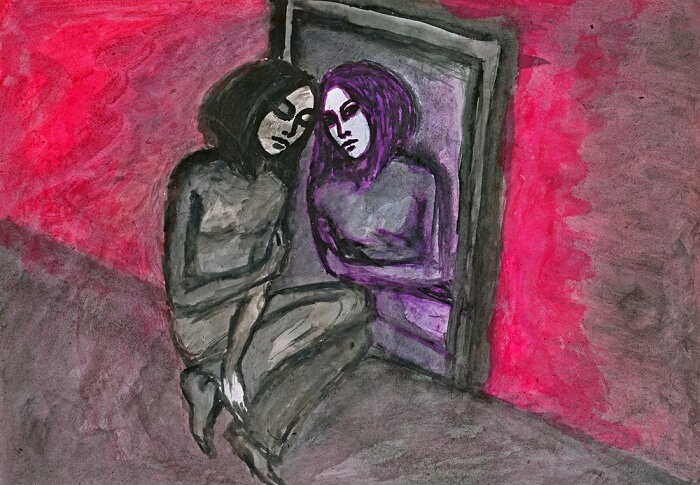Body dysmorphic disorder, also known as BDD, is a relatively common mental disorder, affecting nearly two percent of the population. BDD can manifest in various forms, and symptoms typically first appear during adolescence. Men and women are equally at risk for developing BDD, and the disorder can develop on its own or in concurrence with one or more other mental disorders. Depending upon now an individual’s particular symptoms manifest, BDD can sometimes lead to poor eating habits and the development of eating disorders such as anorexia nervosa or bulimia nervosa.

What Is Body Dysmorphic Disorder?
In an article posted to the National Library of Medicine website by Bjornsson, et al, entitled “Body dysmorphic disorder”:
BDD consists of a distressing or impairing preoccupation with imagined or slight defects in appearance. BDD is commonly considered to be an obsessive-compulsive spectrum disorder.
People suffering from BDD may or may not develop other mental disorders, including eating disorders. A person with BDD whose fixation is his or her hair, for example, would be less likely to develop an eating disorder than would a person who fixates on his or her abdomen.
Symptoms of Body Dysmorphic Disorder
WebMD lists some of the symptoms of BDD as:
- repetitive behaviors such as frequently examining one’s reflection in a mirror or continually touching or picking at the perceived defect;
- intense self-consciousness;
- excessive pursuit of and/or engagement in plastic surgery.
People with BDD may also experience difficulty in their personal or professional lives as their obsession with the perceived defect interferes with everyday functions. For example, a person who fixates on skin imperfections may have difficulty being intimate with a lover, and one who fixates on facial appearance may have debilitating social anxiety.
Causes of Body Dysmorphic Disorder
The exact cause of BDD is unknown, but due to the frequency of sufferers who also have co-occurring disorders such as anxiety and depression, it is likely that there is a biological basis. Environmental factors such as criticism during childhood, low self-esteem, or childhood trauma can be contributors to the development of BDD, as can peer pressure. Societal influences from movies, television, and magazines can also contribute to the development of BDD as an individual may feel pressure to look like the faces he or she sees in the media.
Other Issues that Relate to Body Dysmorphic Disorder
People with BDD frequently suffer from other disorders as well, such as depression, anxiety, obsessive-compulsive disorder, and others. While not all BDD sufferers will develop an eating disorder, it is estimated that 12 percent of individuals with BDD also suffer from anorexia or bulimia. It is important to note, however, that not all individuals with an eating disorder suffer from BDD. People with BDD are typically focused on a specific area of the body rather than a general self-perception of being overweight. Someone with BDD and anorexia may, for example, be specifically fixated on the size of his or her hips.

Body Dysmorphic Disorder Treatment Options
The Mayo Clinic suggests that cognitive behavioral therapy, or CBT, is crucial in treating BDD, but that medication may also be useful in managing some symptoms. Cognitive behavioral therapy is essential in helping to manage and change negative thought patterns, increase self-esteem, and address ritual behaviors such as mirror checking or skin picking. CBT can also provide healthy stress management techniques so that the individual can cope more effectively to external stressors rather than resorting to self-destructive habits. However, due to the probable biological component of BDD, certain medications such as selective serotonin reuptake inhibitors (SSRIs) may also be effective. Other medications may be appropriate in managing symptoms of anxiety. Individuals with co-occurring disorders may require more specialized treatment, as each disorder must be treated individually as well as in the context of the other disorders.
In severe cases, hospitalization may be necessary. Individuals who are at risk of self-harm or who are unable to perform daily tasks may need to be hospitalized for a time in order to receive more focused treatment. Inpatient treatment may include cognitive behavioral therapy and medication alongside therapies such as group therapy, and in the case of patients with eating disorders, nutritional and physical education.
While an individual with BDD may believe that plastic surgery is the solution, it is not advised in the treatment of BDD. An individual with BDD may find that the plastic surgery resolves one perceived defect, only to have another emerge. Individuals with BDD should be referred to a mental health professional before seeking cosmetic surgery.
Body Dysmorphic Disorder in Popular Culture
In recent years, many celebrities have come forward to share their experiences with symptoms of BDD. Hayden Panettiere, star of the television show Nashville, has been extremely vocal on the topic. She says that her symptoms began when, at the age of 16, she saw her photo in a magazine article which pointed out the fact that she had cellulite. Miley Cyrus notes that her symptoms stemmed from her time as a child star playing the role of Hannah Montana.
In 2015, Cyrus told Marie Claire:
I was made to look like someone that I wasn’t, which probably caused some body dysmorphia because I had been made pretty every day for so long.
Robert Pattinson has been known to frequently apologize on the sets of his films for being “ugly,” despite once being named “Sexiest Man Alive” by People Magazine. But perhaps the most famous example of BDD is the late Michael Jackson. Over the course of his lifetime, Jackson had over 30 cosmetic procedures, including several rhinoplasties. His symptoms are said to have been rooted in childhood, when his father is rumored to have been intensely critical of Jackson’s appearance.

Conclusion
Have you or a loved one had experience with body dysmorphic disorder? Tell us your story in the comments. Please share this article on Facebook and Twitter to help us spread the word about this common disorder.
Images from depositphotos.com.
